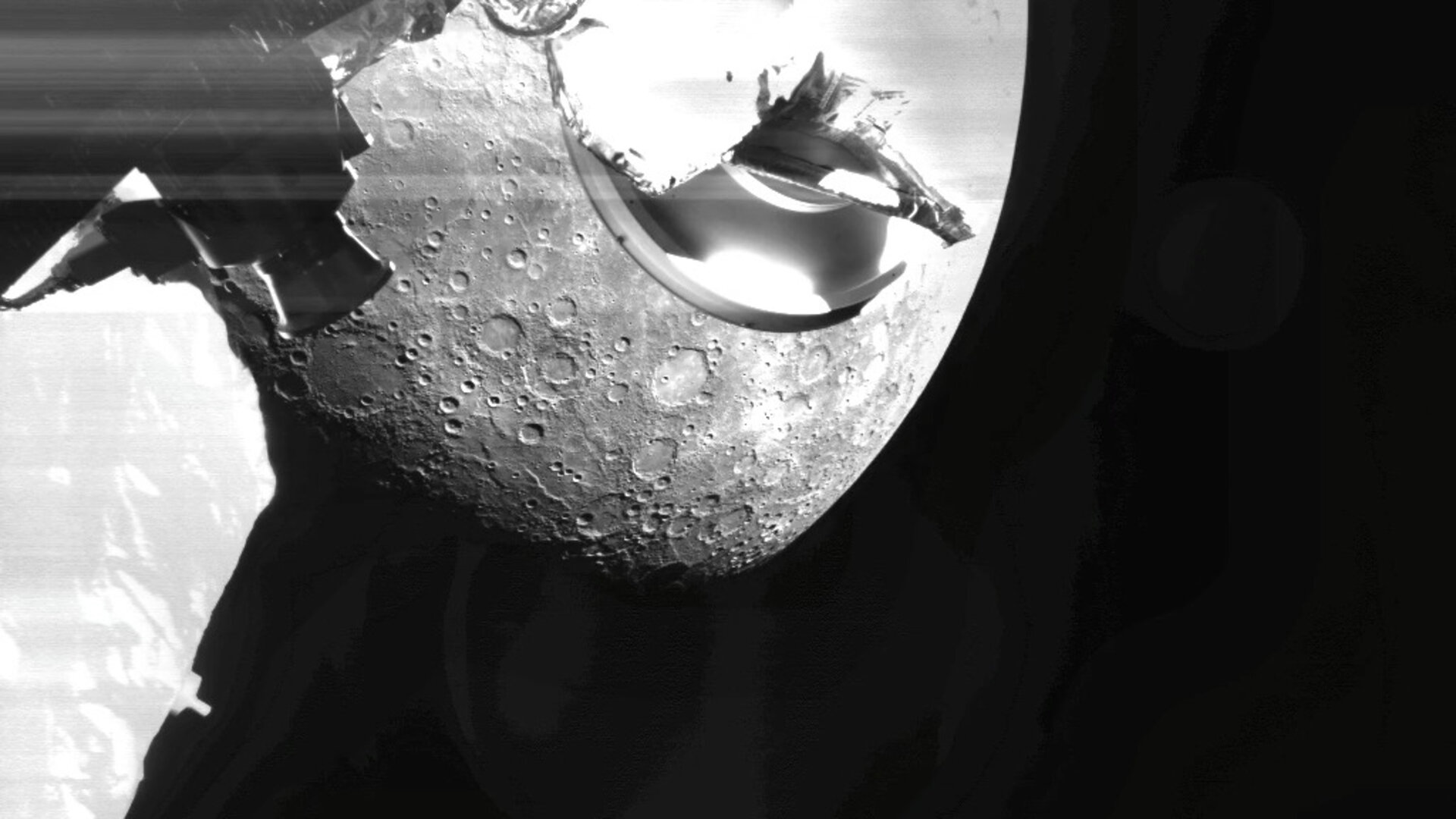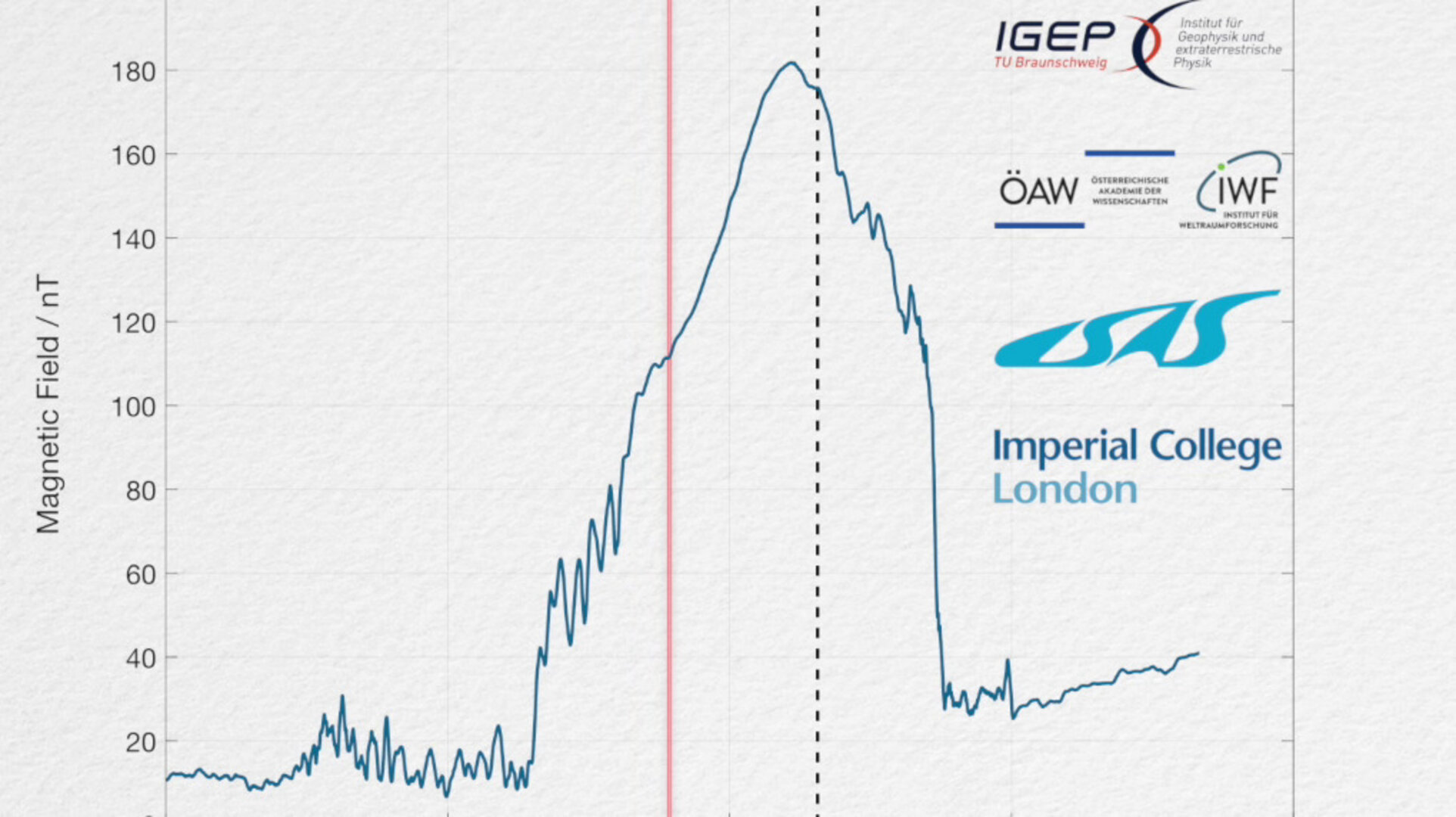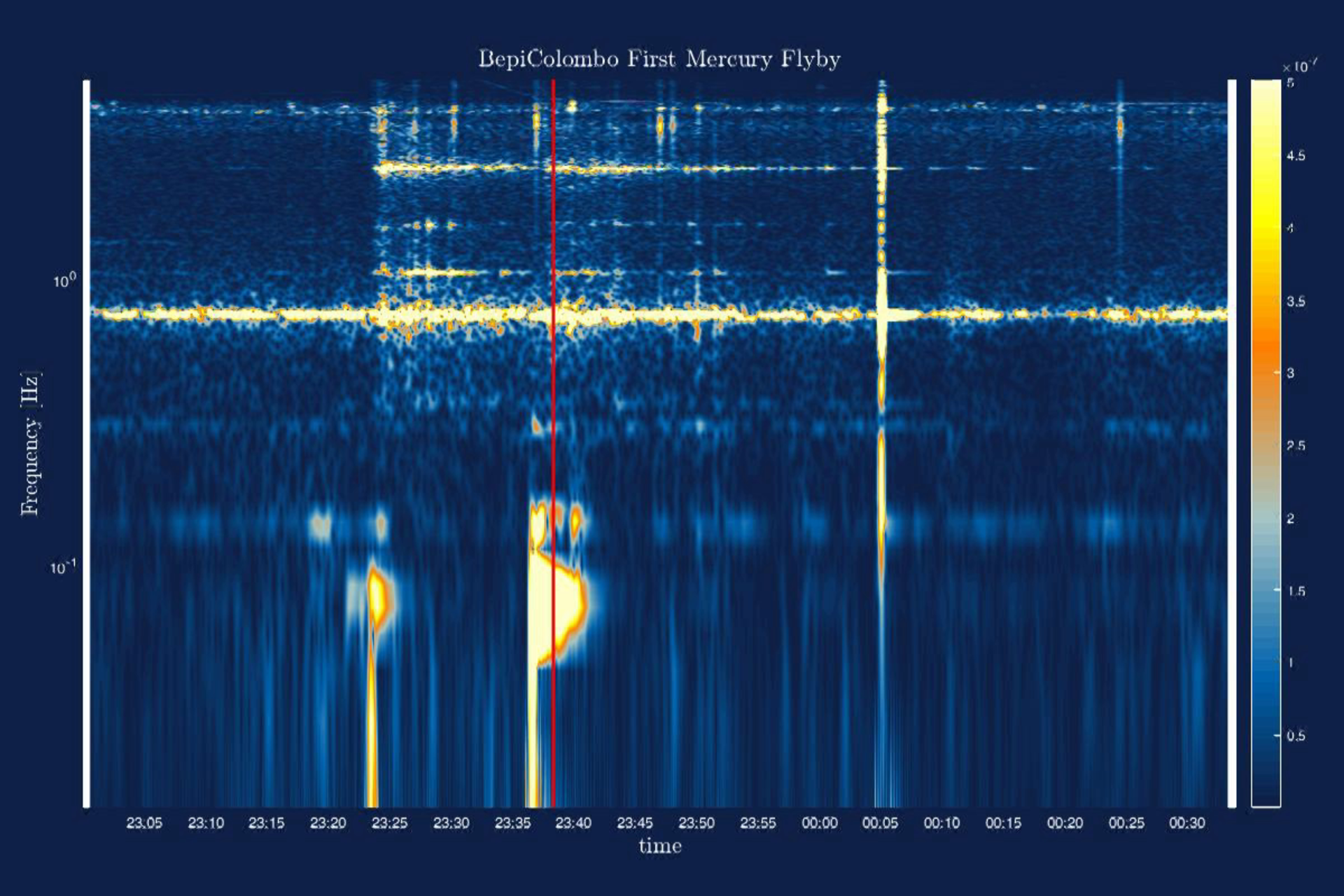BepiColombo’s first tastes of Mercury science
The magnetic and particle environment around Mercury was sampled by BepiColombo for the first time during the mission’s close flyby of the planet at 199 km on 1-2 October 2021, while the huge gravitational pull of the planet was felt by its accelerometers.
The magnetic and accelerometer data have been converted into sound files and presented here for the first time. They capture the ‘sound’ of the solar wind as it bombards a planet close to the Sun, the flexing of the spacecraft as it responded to the change in temperature as it flew from the night to dayside of the planet, and even the sound of a science instrument rotating to its ‘park’ position.
Unexplored territory
“It may have been a fleeting flyby, but for some of BepiColombo’s instruments, it marked the beginning of their science data collection, and a chance to really start preparing for the main mission,” says Johannes Benkhoff, ESA’s BepiColombo project scientist. “These flybys also offer the chance to sample regions around Mercury that will not be accessible once we’re in orbit. In this case BepiColombo provided us insight into the particles present close to the planet, as well as the magnetic field boundaries as it traversed through the magnetosphere at greater distances.”


Access the video
The PHEBUS ultraviolet spectrometer collected data for an hour around the closest approach, focusing on the elements present in the planet’s extremely low-density atmosphere, or exosphere, which is generated either from the solar wind or from the planet’s surface. Clear peaks of hydrogen and calcium were recorded after the close approach, once BepiColombo exited the shadow of Mercury.

Hydrogen and calcium are just two examples of what can be found in the exosphere; once in orbit around Mercury, PHEBUS will characterise Mercury’s exosphere composition and dynamics in great detail, watching how it changes with location and time. PHEBUS is one of several spectrometers that will study Mercury from orbit to understand its surface composition, including looking for ice in permanently shadowed regions of high-latitude craters.
During the flyby, the Mercury Gamma-ray and Neutron Spectrometer (MGNS) was also operated, detecting bright fluxes of neutron and gamma rays. These emissions are known to be produced by the interaction of galactic cosmic rays with the uppermost surface layers of Mercury, and also provide information about the surface composition. A detailed analysis of the data – also from the Venus flyby – is currently in progress.
Magnetic boundaries
Sensors on the magnetometer boom – the structure seen extending from the Mercury Planetary Orbiter (MPO) in some of the MCAM images – recorded details of the solar wind and magnetic field around Mercury. During this flyby, the magnetometer team were particularly excited to collect data from so close over the planet’s southern hemisphere; so far, only Mercury’s northern hemisphere has been magnetically surveyed by NASA's Messenger mission.
“It’s like having just explored North America and seeing South America through binoculars, but unfortunately having to abort the expedition. As a researcher, you’re naturally curious and desperate to go back,” says Daniel Heyner from TU Braunschweig in Germany, who leads the MPO magnetometer researcher group. “That makes this flyby particularly interesting, as it is the first time that data from the planet’s southern hemisphere close to the surface is available – even if it is just a small sample.”


Access the video
The data has been converted into sound to be audible to the human ear. The resulting sonification captures the changing intensity of the magnetic field and solar wind, including the moment the spacecraft crossed the magnetosheath – the highly turbulent boundary region between the solar wind and the magnetosphere around the planet.
Once in Mercury orbit, complementary magnetic field measurements made by both ESA’s MPO and JAXA’s Mercury Magnetospheric Orbiter (known as Mio) will lead to a detailed analysis of the planet’s magnetic field and its source, in order to better understand the origin, evolution and current state of the planet’s interior. Moreover, the two orbiters will travel through different areas of Mercury’s magnetosphere and on different timescales, measuring simultaneously how the magnetic field changes over time and in space, and its relationship to the powerful solar wind.
In the meantime, Daniel and his colleagues will start to follow up on questions such as: can the characteristics of the magnetic field from the northern hemisphere be easily transferred to the southern hemisphere? Has the magnetic field generated by the dynamo perhaps even changed in the last six years after the Messenger mission – as it continuously does on Earth? The new BepiColombo flyby data – and eventually data from its main science mission – will be compared with global magnetic field models created from the Messenger mission to create the most accurate picture yet of Mercury’s magnetic field.
Feeling the crunch
The Italian Spring Accelerometer (ISA) onboard the MPO recorded the accelerations measured by the spacecraft as it experienced the extreme gravitational pull of the planet during the flyby, and the response of the change in temperature as the spacecraft entered and exited the shadow of the planet. Furthermore, ISA detected the motion of the PHEBUS spectrometer as it clicked back into its ‘parking’ bracket after it completed its operations at Mercury.
This information has also been translated into an audio file.


Access the video
“On the acceleration plots that were appearing on our screens, we could see the tidal effects of Mercury on the BepiColombo structure, the drop of the solar radiation pressure during the transit in the shadow of the planet, and the movement of the centre of mass of the spacecraft due to flexing of the large solar arrays,” says Carmelo Magnafico of the Italian National Institute for Astrophysics (INAF). “The real science begins now for us, because in the difference between those expected effects and the actually measured data stands the ISA scientific value. We are extremely happy.”
ISA will support the study of Mercury’s internal structure and test Einstein's theory of General Relativity to an unprecedented level of accuracy. It will also be central to providing accurate orbit determination of the MPO around Mercury, and of Mercury’s centre of mass as it orbits around the Sun.
The October gravity assist manoeuvre was the first at Mercury and the fourth of nine flybys overall. During its seven-year cruise to the smallest and innermost planet of the Solar System, BepiColombo makes one flyby at Earth, two at Venus and six at Mercury to help steer it on course to arrive in Mercury orbit in 2025.
Further science results from the October flyby may be reported in future scientific journals once the science teams have had time to fully analyse the data. All MCAM images are available via the Planetary Science Archive.
For further information, please contact:
ESA media relations
media@esa.int

